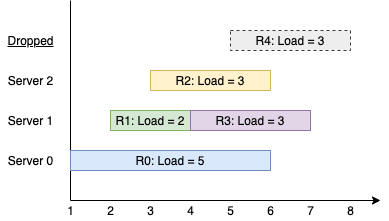原文链接: https://leetcode-cn.com/problems/find-servers-that-handled-most-number-of-requests
英文原文
You have k servers numbered from 0 to k-1 that are being used to handle multiple requests simultaneously. Each server has infinite computational capacity but cannot handle more than one request at a time. The requests are assigned to servers according to a specific algorithm:
- The
ith(0-indexed) request arrives. - If all servers are busy, the request is dropped (not handled at all).
- If the
(i % k)thserver is available, assign the request to that server. - Otherwise, assign the request to the next available server (wrapping around the list of servers and starting from 0 if necessary). For example, if the
ithserver is busy, try to assign the request to the(i+1)thserver, then the(i+2)thserver, and so on.
You are given a strictly increasing array arrival of positive integers, where arrival[i] represents the arrival time of the ith request, and another array load, where load[i] represents the load of the ith request (the time it takes to complete). Your goal is to find the busiest server(s). A server is considered busiest if it handled the most number of requests successfully among all the servers.
Return a list containing the IDs (0-indexed) of the busiest server(s). You may return the IDs in any order.
Example 1:

Input: k = 3, arrival = [1,2,3,4,5], load = [5,2,3,3,3] Output: [1] Explanation: All of the servers start out available. The first 3 requests are handled by the first 3 servers in order. Request 3 comes in. Server 0 is busy, so it's assigned to the next available server, which is 1. Request 4 comes in. It cannot be handled since all servers are busy, so it is dropped. Servers 0 and 2 handled one request each, while server 1 handled two requests. Hence server 1 is the busiest server.
Example 2:
Input: k = 3, arrival = [1,2,3,4], load = [1,2,1,2] Output: [0] Explanation: The first 3 requests are handled by first 3 servers. Request 3 comes in. It is handled by server 0 since the server is available. Server 0 handled two requests, while servers 1 and 2 handled one request each. Hence server 0 is the busiest server.
Example 3:
Input: k = 3, arrival = [1,2,3], load = [10,12,11] Output: [0,1,2] Explanation: Each server handles a single request, so they are all considered the busiest.
Example 4:
Input: k = 3, arrival = [1,2,3,4,8,9,10], load = [5,2,10,3,1,2,2] Output: [1]
Example 5:
Input: k = 1, arrival = [1], load = [1] Output: [0]
Constraints:
1 <= k <= 1051 <= arrival.length, load.length <= 105arrival.length == load.length1 <= arrival[i], load[i] <= 109arrivalis strictly increasing.
中文题目
你有 k 个服务器,编号为 0 到 k-1 ,它们可以同时处理多个请求组。每个服务器有无穷的计算能力但是 不能同时处理超过一个请求 。请求分配到服务器的规则如下:
- 第
i(序号从 0 开始)个请求到达。 - 如果所有服务器都已被占据,那么该请求被舍弃(完全不处理)。
- 如果第
(i % k)个服务器空闲,那么对应服务器会处理该请求。 - 否则,将请求安排给下一个空闲的服务器(服务器构成一个环,必要的话可能从第 0 个服务器开始继续找下一个空闲的服务器)。比方说,如果第
i个服务器在忙,那么会查看第(i+1)个服务器,第(i+2)个服务器等等。
给你一个 严格递增 的正整数数组 arrival ,表示第 i 个任务的到达时间,和另一个数组 load ,其中 load[i] 表示第 i 个请求的工作量(也就是服务器完成它所需要的时间)。你的任务是找到 最繁忙的服务器 。最繁忙定义为一个服务器处理的请求数是所有服务器里最多的。
请你返回包含所有 最繁忙服务器 序号的列表,你可以以任意顺序返回这个列表。
示例 1:

输入:k = 3, arrival = [1,2,3,4,5], load = [5,2,3,3,3] 输出:[1] 解释: 所有服务器一开始都是空闲的。 前 3 个请求分别由前 3 台服务器依次处理。 请求 3 进来的时候,服务器 0 被占据,所以它呗安排到下一台空闲的服务器,也就是服务器 1 。 请求 4 进来的时候,由于所有服务器都被占据,该请求被舍弃。 服务器 0 和 2 分别都处理了一个请求,服务器 1 处理了两个请求。所以服务器 1 是最忙的服务器。
示例 2:
输入:k = 3, arrival = [1,2,3,4], load = [1,2,1,2] 输出:[0] 解释: 前 3 个请求分别被前 3 个服务器处理。 请求 3 进来,由于服务器 0 空闲,它被服务器 0 处理。 服务器 0 处理了两个请求,服务器 1 和 2 分别处理了一个请求。所以服务器 0 是最忙的服务器。
示例 3:
输入:k = 3, arrival = [1,2,3], load = [10,12,11] 输出:[0,1,2] 解释:每个服务器分别处理了一个请求,所以它们都是最忙的服务器。
示例 4:
输入:k = 3, arrival = [1,2,3,4,8,9,10], load = [5,2,10,3,1,2,2] 输出:[1]
示例 5:
输入:k = 1, arrival = [1], load = [1] 输出:[0]
提示:
1 <= k <= 1051 <= arrival.length, load.length <= 105arrival.length == load.length1 <= arrival[i], load[i] <= 109arrival保证 严格递增 。
通过代码
高赞题解
- 将所有运行的机器全部进入优先级队列,队列元素保存当前机器运行任务结束的时间。
- 由于
arrive的时间是严格递增的,所以每次测试将所有可能的机器全部出队列,加入到free的列表中。 - 如果当前的
free列表为空,则表示该任务不可运行,则我们利用二分查找找到第一个目标机器即可。typedef pair<int,int> pii; class Solution { public: vector<int> busiestServers(int k, vector<int>& arrival, vector<int>& load) { int n = arrival.size(); int target = 0; int maxService = 0; vector<int> ans; priority_queue<pii,vector<pii>,greater<pii>> pq; vector<int> count(k,0); set<int> wait; for(int i = 0; i < k; ++i){ wait.insert(i); } for(int i = 0; i < n; ++i){ while(!pq.empty() && pq.top().first <= arrival[i]){ wait.insert(pq.top().second); pq.pop(); } int curr = i%k; if(wait.empty()) continue; auto it = wait.lower_bound(curr); if(it != wait.end()){ target = *it; }else{ target = *wait.begin(); } count[target]++; wait.erase(target); pq.push(make_pair(arrival[i] + load[i],target)); maxService = max(maxService,count[target]); } for(int i = 0; i < k; ++i){ if(count[i] == maxService) ans.push_back(i); } return ans; } };
统计信息
| 通过次数 | 提交次数 | AC比率 |
|---|---|---|
| 1731 | 4989 | 34.7% |
提交历史
| 提交时间 | 提交结果 | 执行时间 | 内存消耗 | 语言 |
|---|




